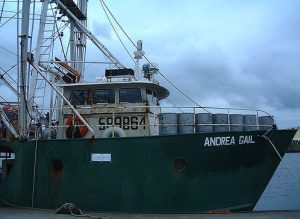 Overdue is never a good thing, but there are some times when being overdue is a very bad thing. One of those times is when a plane, train, or ship are overdue. Andrea Gail began her final voyage departing from Gloucester Harbor, Massachusetts, on September 20, 1991, bound for the Grand Banks of Newfoundland off the coast of eastern Canada. After poor fishing, Captain Frank W “Billy” Tyne Jr headed east to the Flemish Cap where he believed they would have better luck. The fishing was much better there, and before long, the crew had filled the storage bins with fish. It was at that point that the ship’s ice machine began malfunctioning. Because they could not maintain the catch without the ice, Tyne set course for home on October 26–27.
Overdue is never a good thing, but there are some times when being overdue is a very bad thing. One of those times is when a plane, train, or ship are overdue. Andrea Gail began her final voyage departing from Gloucester Harbor, Massachusetts, on September 20, 1991, bound for the Grand Banks of Newfoundland off the coast of eastern Canada. After poor fishing, Captain Frank W “Billy” Tyne Jr headed east to the Flemish Cap where he believed they would have better luck. The fishing was much better there, and before long, the crew had filled the storage bins with fish. It was at that point that the ship’s ice machine began malfunctioning. Because they could not maintain the catch without the ice, Tyne set course for home on October 26–27.
The weather reports warned of dangerous weather conditions, and he knew it would be risky, but he thought they could make a run for home, and possibly beat the storm. The problem was that this was no ordinary storm. Two systems were colliding, and creating the perfect storm. It was the perfect situation for an impossible passage for the Andrea Gail. His friend, Linda Greenlaw, tried to warn Tyne not to try it. She was looking at the weather report and she could see that this storm was not one to be taken lightly. Nevertheless, Tyne headed for Massachusetts. His last reported transmission was at about 6:00pm on October 28, 1991, when he radioed Greenlaw, who was the Captain of the Hannah Boden, and gave his coordinates as 44°00 N 56°40 W, or about 162 miles east of Sable Island. He also gave a weather report indicating 30 foot seas and wind gusts up to 80 knots. Tyne’s final recorded words were “She’s comin’ on, boys, and she’s comin’ on strong.” It was reported that the storm created waves in excess of 100 feet in height, but ocean buoy monitors recorded a peak wave height of 39 feet, and so waves of 100 feet were deemed “unlikely” by Science Daily. However, data from a series of weather buoys in the general vicinity of the vessel’s last known location recorded peak wave action exceeding 60 feet in height from October 28 through 30, 1991.
The Andrea Gail was officially reported overdue on October 30, 1991. An extensive air and land search was launched by the 106th Rescue Wing from the New York Air National Guard, United States Coast Guard and Canadian Coast Guard forces. The search would eventually cover over 186,000 square nautical miles. Finally, on November 6, 1991, Andrea Gail’s emergency position-indicating radio beacon (EPIRB) was discovered  washed up on the shore of Sable Island in Nova Scotia…not the news they were hoping for. The EPIRB was designed to automatically send out a distress signal upon contact with sea water, but the Canadian Coast Guard personnel who found the beacon “did not conclusively verify whether the control switch was in the on or off position”. By November 9th, authorities officially called off the search for the missing Andrea Gail, due to the low probability of crew survival. Fuel drums, a fuel tank, the EPIRB, an empty life raft, and some other flotsam were the only wreckage ever found. The ship was presumed lost at sea somewhere along the continental shelf near Sable Island. Sometimes, overdue is the worst possible situation.
washed up on the shore of Sable Island in Nova Scotia…not the news they were hoping for. The EPIRB was designed to automatically send out a distress signal upon contact with sea water, but the Canadian Coast Guard personnel who found the beacon “did not conclusively verify whether the control switch was in the on or off position”. By November 9th, authorities officially called off the search for the missing Andrea Gail, due to the low probability of crew survival. Fuel drums, a fuel tank, the EPIRB, an empty life raft, and some other flotsam were the only wreckage ever found. The ship was presumed lost at sea somewhere along the continental shelf near Sable Island. Sometimes, overdue is the worst possible situation.


Leave a Reply